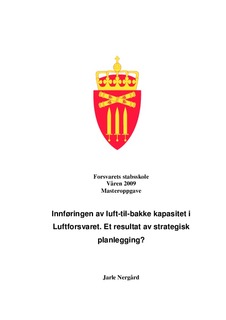| dc.description.abstract | This study seeks to explore and understand the strategy process in the Norwegian defence forces when the Royal Norwegian Air Force implemented an air to ground capability in the F-16 fleet during the late 1990’s. The study utilizes two theories on how strategy is developed in organisations as a tool for understanding the process mentioned above. One view is that the organisation’s strategy is formulated at the top of the organisation, normally by the Chief Executive Officer (CEO) or his planning staff. The strategy is then written down in plans, and distributed throughout the organisation for implementation. The other view is that strategy forms by the sum of initiatives or actions taken anywhere (but mostly at lower levels) in the organisation. Effective strategies emerge, and become the organisation’s strategy when the initiatives become collective, and they represent a consistent pattern of behaviour in the organisation over some period of time. The study is mainly based on strategic plans written by the Chief of Defence Norway planning staff between 1993 and 1999, as well as interviews with 10 persons working at different levels in the armed forces during the late 1990’s ranging from the Chief of Defence at the top, to a combat ready fighter pilot at the lowest level in the organisation. | en_US |
